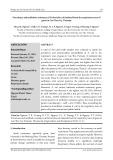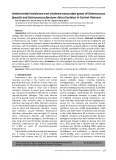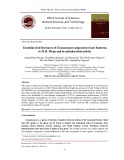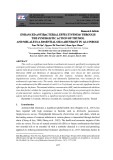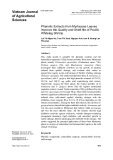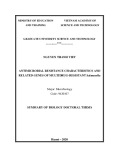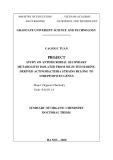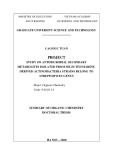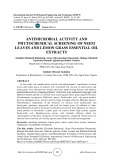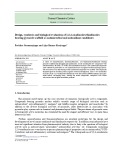doi:10.1111/j.1432-1033.2004.04018.x
Eur. J. Biochem. 271, 1145–1152 (2004) (cid:2) FEBS 2004
The transporters Pdr5p and Snq2p mediate diazaborine resistance and are under the control of the gain-of-function allele PDR1-12
Eva Wehrschu¨ tz-Sigl*, Helmut Jungwirth*, Helmut Bergler and Gregor Ho¨ genauer
Institut fu¨r Molekularbiologie, Biochemie und Mikrobiologie, Karl-Franzens-Universita¨t Graz, Austria
in the PDR3-33 mutant diazaborine resistance is exerted mainly via overexpression of the PDR5 and SNQ2 genes, while in the PDR1-12 mutant, additional genes, i.e. the Yap1p target genes FLR1 and YCF1, are also involved in diazaborine detoxification. In addition, we show that in the presence of cycloheximide or diazaborine PDR5 can be activated by additional transcription factors beside Pdr1p and Pdr3p.
Keywords: diazaborine; ABC transporters; transcriptional regulation; Saccharomyces cerevisiae.
The spontaneous acquisition of resistance to a variety of unrelated cytotoxic compounds has important implications in medical treatment of infectious diseases and anticancer therapy. In the yeast Saccharomyces cerevisiae this pheno- menon is caused by overexpression of membrane efflux pumps and is called pleiotropic drug resistance. We have found that allelic forms of the genes for the transcription activators Pdr1p and Pdr3p, designated PDR1-12 and PDR3-33, respectively, mediate resistance to diazaborine. Here we demonstrate that the transporters Pdr5p and Snq2p are involved in diazaborine detoxification. We report that
The second group of transcription factors regulating efflux protein expression is the Yap-family, which contains a bZIP structural motif [3,6]. We recently reported that the ABC transporter, Ycf1p and the MFS transporter, Flr1p play a crucial role in YAP1-mediated diazaborine resistance [7]. Diazaborines are heterocyclic boron containing com- pounds which exhibit strong antibacterial activity and also inhibit growth of yeast cells [8–10]. Furthermore, our studies on the effect of diazaborine on yeast cells showed that gain- of-function alleles of both PDR1 and PDR3, designated PDR1-12 and PDR3-33, also mediate high level diazaborine resistance phenotypes. Interestingly, the PDR1-12 allele was much more resistant to the drug than the PDR3-33 allele [10].
Yeast Saccharomyces cerevisiae is equipped with a detoxi- fication mechanism called the pleiotropic drug resistance (PDR) network, which protects the cell from a number of structurally and functionally unrelated toxic compounds [1,2]. The PDR-system involves complex interactions between a set of regulatory proteins and membrane- located efflux pumps from the ATP-binding-cassette (ABC) or the major facilitator superfamily (MFS) type, which eliminate toxic compounds from the cell [1,3]. The master regulators of the PDR-network are the zinc- containing transcription activators, Pdr1p and Pdr3p [4,5]. The plasma membrane located efflux pumps Pdr5p and Snq2p are by now the best characterized yeast ABC transporters involved in pleiotropic drug resistance. Both proteins, Pdr5p and Snq2p, are under the genetic control of the transcription factors Pdr1p and Pdr3p (reviewed in [3]). Various mutations in both Pdr1p and Pdr3p or multicopy overproduction of the wild-type genes are known to cause overexpression of the efflux pumps Pdr5p and Snq2p thereby mediating drug resistance (reviewed in [1]).
In this paper we describe the relevance of the transporters Pdr5p and Snq2p in the Pdr1p- or the Pdr3p- mediated diazaborine resistance. Furthermore, we found that Flr1p and Ycf1p, which are two efflux-pumps under the control of Yap1p are necessary for full development of the resistant phenotype in the PDR1-12 mutant. We also found that PDR5-mRNA is increased in a strain lacking the PDR1 and the PDR3 genes in the presence of cycloheximide or diazaborine, indicating that yet another transcription factor must regulate this gene. We also demonstrate an increase of the PDR3 mRNA level due to the gain-of-function allele PDR1-12.
Material and methods
Yeast strains and media
S. cerevisiae strains used in this study are listed in Table 1. Cells were grown in rich medium (YPD) or synthetic medium (SD), supplemented with appropriate nutrients for maintenance of plasmids, as described by Sherman et al. [11]. Yeast was grown routinely at 30 (cid:1)C.
Correspondence to G. Ho¨ genauer, Institut fu¨ r Molekularbiologie, Biochemie und Mikrobiologie, Karl-Franzens-Universita¨ t Graz, Universita¨ tsplatz 2, A-8010 Graz, Austria. Fax: + 43 316 380 9898, Tel.: + 43 316 380 5683, E-mail: gregor.hoegenauer@kfunigraz.ac.at Abbreviations: ABC transporter, ATP-binding cassette transporter; MFS transporter, major facilitator superfamily transporter; PDR, pleiotropic drug resistance; PDRE, Pdr1p/Pdr3p response element. *Note: These authors contributed equally to this work. Note: A website is available at http://www.kfunigraz.ac.at/imbmwww/ (Received 2 September 2003, revised 8 January 2004, accepted 30 January 2004)
(cid:2) FEBS 2004
1146 E. Wehrschu¨ tz-Sigl et al. (Eur. J. Biochem. 271)
Table 1. Genotypes of strains used in this study.
Strain Genotype Source/reference
Plasmids
FY1679–28C FY1679–28C Dpdr1Dpdr3 FY1679–28C Dpdr1Dpdr3Dyap1 A2 KPHJ1 KPHJ2 W303a W303Dflr1Dycf1 YPH500 YKKB-13 YYM3 YYM5 MATa ura3 leu2 his3 trp1 MATa ura3 leu2 his3 trp1 pdr1D::TRP1, pdr3D::HIS3 MATa ura3 leu2 his3 trp1 pdr1D::TRP1, pdr3D::HIS3 yap1D::hisG MATa leu2 his3 can1 MATa leu2 his3 can1 PDR1-12::HIS3 MATa leu2 his3 can1 PDR3-33::HIS3 MATa ura3 leu2 his3 trp1 ade2 MATa ura3 leu2 his3 trp1 ade2 can1 flr1D::URA3 ycf1D::kanMX6 MATa ura3 his3 leu2 trp1 lys2 ade2 MATa ura3 his3 leu2 trp1 lys2 ade2 pdr5D::TRP1 MATa ura3 his3 leu2 trp1 lys2 ade2, pdr5D::TRP1 snq2D::hisG MATa ura3 his3 leu2 trp1 lys2 ade2 snq2D::hisG K. Kuchler K. Kuchler K. Kuchler V. L. MacKay [7] [7] S. D. Kohlwein [7] K. Kuchler K. Kuchler K. Kuchler K. Kuchler
Results
Overexpression of PDR5 and SNQ2causes diazaborine resistance
The multicopy plasmids, YEp13, pYSTS1, containing gene PDR5 in YEp13 and pSYS1 (SNQ2) were a gift from K. Kuchler. The multicopy plasmids, YEp351, pKP100 (PDR1-12) and pKP300 (PDR3-33), containing allelic forms of genes PDR1 and PDR3 in YEp351, were described before [10]. Plasmids were transformed into S. cerevisiae using the lithium acetate method of Gietz et al. [12].
Measurement of growth inhibition by diazaborine
We have shown that a pdr5 deletion strain was more sensitive to diazaborine than the isogenic wild-type strain [10]. This experiment reveals a possible link between PDR5 and diazaborine detoxification. To investigate whether overexpression of PDR5 causes diazaborine resistance, yeast strain W303 was transformed with the multicopy plasmid pYSTS1, carrying gene PDR5, or the empty vector alone, which served as a control. These strains were tested for growth in the presence of various diazaborine concen- trations. As shown in Fig. 1, the strain overexpressing PDR5 was more resistant to diazaborine than the strain with the empty vector. In order to asses a possible role of the efflux pump Snq2p in diazaborine resistance, the multicopy plasmid pYSNQ2 with the gene SNQ2 was transformed
The effects of diazaborine on different yeast strains were quantitated by growing them overnight in YPD medium or, when plasmid carrying strains were used, in minimal medium lacking leucine. The cell suspension was diluted to an A600 of 0.1. This suspension was then spotted on YPD plates containing a gradient of diazaborine (maximal concentration of 200 lgÆmL)1; Novartis Research Insti- tute, Vienna, Austria) or a gradient of cycloheximide (maximal concentration of 0.5 lgÆmL)1). Alternatively, the diluted overnight cultures were further diluted in tenfold increments. Five microlitres of each of these dilutions were spotted on YPD plates with or without inhibitor. Each experiment was repeated at least three times.
Northern blot analysis
Yeast strains were grown overnight in YPD medium. The cells were diluted to a D600 of 0.05 and cultured to a D600 of 0.3–0.4. Samples of total RNA were prepared from each aliquot as described in the Qiagen RNeasy Handbook. RNA samples (20 lg) were denatured and separated on a 1.2% (w/v) agarose gel containing 1.2 M formaldehyde and transferred to Hybond N (Amersham) filters. Hybridiza- tion was performed in 0.5 M Na2HPO4, pH 7.2, 1 mM EDTA, 7% (w/v) SDS, 1% (w/v) BSA and 100 lgÆmL)1 salmon-sperm DNA with 32P-labeled DNA probes at 65 (cid:1)C for 12–16 h. The filters were washed four times in 40 mM Na2HPO4, pH 7.2, 1% (w/v) SDS, at 65 (cid:1)C for 25 min, and the radioactivity was made visible by autoradiography at )70 (cid:1)C and quantitated on a densitometer. As an internal control, the yeast gene ACT1 (Harata et al. [13]) was used.
Fig. 1. Overexpression of PDR5 and SNQ2 genes confers diazaborine resistance. The strain W303 carrying either the empty vector pYEp13 (2 lm), PDR5 on the multicopy plasmid pYSTS1 (2 lm PDR5), or SNQ2 on the multicopy plasmid pYSNQ2 (2 lm SNQ2), were spotted on YPD-plates containing no or 80 lgÆmL)1 diazaborine.
Pdr5p and Snq2p mediate diazaborine resistance (Eur. J. Biochem. 271) 1147
(cid:2) FEBS 2004
shown). However, when both, PDR5 and SNQ2, were deleted, PDR3-33 was unable to confer resistance. Hence, we conclude that PDR3-33 mediated diazaborine resistance is exclusively dependent on the ABC transporters PDR5 and SNQ2.
into S. cerevisiae W303. The SNQ2 overexpressing strain was again more resistant to diazaborine relative to a strain carrying the empty vector (Fig. 1). These results show that both efflux pumps, Pdr5p and Snq2p, contribute to diazaborine detoxification.
PDR3-33 mediated diazaborine resistance depends on functional PDR5 and SNQ2 genes
Additional transporters are involved in PDR1-12 mediated diazaborine resistance
To define the contribution of Pdr5p and Snq2p on PDR3 mediated diazaborine resistance, yeast strains YKKB13 and YYM5, which are disrupted in genes SNQ2 and PDR5, respectively, were transformed with the multicopy plasmid pKP300, carrying the PDR3-33 allele. Similarly, the double mutant Dpdr5Dsnq2 and the wild-type strain YPH500 were also transformed with the same plasmid. Additionally, a control, containing the empty vector, was carried along. Diazaborine resistance was determined on a plate contain- ing a drug gradient. As observed before, the Dpdr5 strain containing the empty vector grew poorly in the presence of the drug, while the Dsnq2 strain grew like the wild-type [10]. Thus, the deletion of SNQ2 does not influence the resistance of the respective strain. Although Pdr5p seems to contribute mostly to the drug tolerance of the wild-type, the allelic form of the relevant transcription factor, PDR3-33, could still confer diazaborine resistance in the Dpdr5 strain (Fig. 2). Similarly, deletion of SNQ2 alone did not influence the level of PDR3-33 mediated diazaborine resistance (data not
In an earlier publication, we have shown that strains carrying the PDR1-12 allele are much more resistant to the drug diazaborine than those carrying the PDR3-33 allele [10]. This effect is partially due to elevated transcript levels of PDR5 and SNQ2 in the PDR1-12 mutant relative to the PDR3-33 mutant strain as shown by the Northern blot in Fig. 3. However, involvement of additional trans- porters could not be excluded. Therefore, the double disruptant Dpdr5Dsnq2 and the wild-type strain were transformed with the plasmids pKP100 (PDR1-12), or the empty vector. These strains were again tested on a plate containing a drug gradient. As shown in Fig. 4, the Dpdr5Dsnq2 strain carrying the plasmid pKP100 was less resistant than the wild-type strain with the plasmid. However, the Dpdr5Dsnq2 disruptant strain with pKP100 was still more resistant than the strain with the empty the idea that PDR1-12 vector. These results support activates at least one additional transporter which contri- butes to diazaborine resistance.
Fig. 3. Northern blots showing expression of PDR5 and SNQ2 mRNA. Total RNA was extracted from S. cerevisiae A2 (wild-type), KPHJ1 (PDR1-12) and KPHJ2 (PDR3-33). Radioactive probes of PDR5 (A) and SNQ2 (B) were used in this experiment and the positions of the mRNAs are indicated on the right. The amount of 26S and 18S rRNA was used with each sample as a control for monitoring RNA loading. Fig. 2. Overexpression of the allelic form PDR3-33 does not confer diazaborine resistance in the Dpdr5Dsnq2 strain. The strains YPH500 (wt), YKKB-13 (Dpdr5), and YYM3 (Dpdr5Dsnq2) carrying either the empty vector pYEp351 (2 lm), or the allelic form PDR3-33 on the multicopy plasmid pKP300 (2 lm PDR3-33), were spotted onto YPD plates containing a gradient of diazaborine (maximal concentration 150 lgÆmL)1) and tested for growth. The direction and relative strength of the gradient is indicated below.
(cid:2) FEBS 2004
1148 E. Wehrschu¨ tz-Sigl et al. (Eur. J. Biochem. 271)
account for the lack of resistance in the Dflr1Dycf1 double mutant.
Fig. 5. Overexpression of PDR1-12 in a Dycf1Dflr1 strain does not mediate resistance. The strains, W303 and the isogenic Dycf1Dflr1 disruptant carrying either the empty vector, pYEp351 (2 lm), or the allelic form, PDR1-12, on the multicopy plasmid, pKP100 (2 lm PDR1-12), were spotted on YPD-plates containing no or 50 lgÆmL)1 diazaborine.
Pdr1p and Pdr3p are not the only transcriptional activators regulating PDR5 expression
FLR1 and YCF1 contribute to PDR1-12 mediated diazaborine resistance
As we had earlier observed a crosstalk between the Yap1p controlled detoxification system and the PDR network [10], we decided to examine a possible regulation of the YAP1 controlled efflux pumps Ycf1p and Flr1p by the transcrip- tion factor Pdr1p. Thus, the wild-type strain W303 and the strain Dflr1Dycf1 were transformed with the plasmid pKP100 (PDR1-12) or the empty vector. Diazaborine resistance of the transformants was determined. As shown in Fig. 5, PDR1-12 could not confer resistance to high concentrations of diazaborine in the double disruptant. This result indicates that, besides Pdr5p and Snq2p, the YAP1 controlled efflux pumps Ycf1p and Flr1p play a crucial role in PDR1-12 mediated diazaborine resistance. In addition, this finding, together with our previous finding that YAP1 mediated diazaborine resistance is strongly dependent on functional PDR1 and PDR3 genes, could indicate that PDR1 and/or PDR3 are important for full expression of YCF1 and FLR1. For FLR1 regulation, the involvement of Pdr3p was shown previously [14]. A plausible explanation for this effect would be that genes YCF1 and FLR1 were directly under the control of transcription factor Pdr1. We tested this possibility by measuring the mRNA levels of FLR1 and YCF1 in the PDR1-12 strain. No significant differences as compared to the wild-type levels were observed (data not shown). Therefore a different mechan- ism than an enhanced transcription by Pdr1–12p has to
To examine a possible involvement of additional transcrip- tional transactivators on the PDR5 expression, its gene on a multicopy plasmid was transformed into the Dpdr1Dpdr3 strain. When we tested the double mutant strain for resistance against diazaborine and cycloheximide, we found that the strain overexpressing PDR5 was clearly more resistant than the strain with the empty vector (Fig. 6). This result shows that PDR1 and PDR3 cannot be the only transcription activators involved in PDR5 expression. As YAP1 was connected with heat shock-induced PDR5 expression [15], we performed the same experiment with a Dpdr1Dpdr3Dyap1 triple mutant. As shown in Fig. 6, deletion of YAP1 had no effect on PDR5-mediated resistance to diazaborine and cycloheximide. A similar behaviour was observed for the gene SNQ2, which still mediated diazaborine resistance in the absence of YAP1, PDR1 and PDR3 (Fig. 7). To investigate the expression of PDR5 in the presence of the inhibitors, RNA from the drug treated Dpdr1Dpdr3 and Dpdr1Dpdr3Dyap1 strains was extracted and analyzed by Northern blotting using a PDR5 specific probe. Treatment of the wild-type strain with cycloheximide resulted in increased expression of the PDR5 gene. Figure 8 shows the result after cycloheximide and diazaborine treatment. In the untreated Dpdr1Dpdr3 strain, no PDR5 mRNA could be detected. However, when this strain was treated with cycloheximide, a clear signal was found. This signal was much stronger when PDR5 was on a multicopy plasmid. The Dpdr1Dpdr3Dyap1 triple mutant behaved similarly to the double mutant. We infer from these experiments that YAP1 has no influence on drug induced
Fig. 4. Overexpression of the allelic form PDR1-12 does still confer diazaborine resistance in the Dpdr5Dsnq2 strain. The strains, YPH500 (wt), YKKB-13 (Dpdr5) and YYM3 (Dpdr5Dsnq2) carrying either the empty vector, pYEp351 (2 lm), or the allelic form, PDR1-12, on the multicopy plasmid pKP100 (2 lm PDR1-12), were spotted onto YPD plates containing a gradient of diazaborine (maximal concentration 150 lgÆmL)1) and tested for growth. The direction and relative strength of the gradient is indicated below.
Pdr5p and Snq2p mediate diazaborine resistance (Eur. J. Biochem. 271) 1149
(cid:2) FEBS 2004
Fig. 7. Deletion of YAP1 has no effect on SNQ2-mediated diazaborine resistance. The wild-type strain, FY1679–28C (wt) and the deletion strains, Dpdr1Dpdr3 and Dpdr1Dpdr3Dyap1, carrying either SNQ2 on a multicopy plasmid (2 lm SNQ2), or the empty vector (2 lm), were spotted on YPD plates containing a gradient of diazaborine (maximal concentration 50 lgÆmL)1) and tested for growth. The direction and relative strength of the gradient is indicated below.
Delahodde et al. [18] have shown that gene PDR3 is autoregulated and that this transcriptional autoregulation process is relevant for the response to cycloheximide. Due to the functional homologies of Pdr3p and Pdr1p, we inves- tigated the PDR1-12 transcript level in the PDR1-12 mutant strain. We measured the abundance of PDR1-12 mRNA by Northern blot analysis. Our studies demonstrated that in the PDR1-12 mutant, the amount of PDR1-12 transcript was increased when compared to the isogenic wild-type strain (Fig. 10). This result might be an indication for a positive autoregulatory feedback loop in the case of Pdr1p. However, a reporter construct with the PDR1 promoter followed by a lacZ gene showed no increased b-galacto- sidase levels. The higher PDR1-mRNA level needs another explanation, e.g. an enhanced mRNA stability in the PDR1-12 transformant.
expression of PDR5 and SNQ2. However, the important finding from these experiments is that there must be an additional transcription factor for PDR5 expression that becomes active only in the presence of the inhibitors.
Fig. 6. Overexpression of PDR5 in a Dpdr1Dpdr3 strain still confers resistance. The deletion strains, Dpdr1Dpdr3 and Dpdr1Dpdr3Dyap1 and the appropriate wild-type strain, FY1679–28C (wt) containing either PDR5 on a multicopy plasmid (2 lm PDR5), or the empty vector (2-lm), were tested for growth on plates containing a gradient of diazaborine (maximal concentration 40 lgÆmL)1) or cycloheximide (maximal concentration 0.5 lgÆmL)1). The direction and relative strength of the gradient is indicated below.
Discussion
The mutation in PDR1-12 leads to an increase of PDR1 and PDR3 mRNA
We have shown previously that allelic forms of PDR1 and PDR, designated PDR1-12 and PDR3-33, cause resistance to the drug diazaborine in yeast. Like other multiple drug resistant PDR1 and PDR3 mutants, the strains with the diazaborine resistant alleles showed increased levels of Pdr5p and Snq2p [10]. Interestingly, a strain deleted for PDR5 and SNQ2 proved to be more sensitive to the drug than the wild-type strain. This finding indicated that these two efflux pumps could be responsible for PDR1-12 or PDR3-33 mediated diazaborine resistances. In this paper, we report that overexpression of both genes, PDR5 and SNQ2, confers diazaborine resistance. Northern blot ana- lyses revealed that the gain-of-function alleles, PDR1-12
Pdr1p belongs to the large family of Zn(II)2Cys6 transcrip- tion factors and binds to a DNA-element, called Pdr1p/ Pdr3p response element (PDRE) [3–5,16,17]. The fact that gene PDR3 contains two PDREs and is regulated by Pdr1p, prompted us to test whether PDR1-12 has any effect on PDR3 mRNA expression. Northern blot experiments showed higher levels of PDR3 mRNA in the PDR1-12 mutant strain relative to the isogenic wild-type (Fig. 9). This result shows that the gain-of-function allele PDR1-12 results in an increased production of PDR3 mRNA.
(cid:2) FEBS 2004
1150 E. Wehrschu¨ tz-Sigl et al. (Eur. J. Biochem. 271)
Fig. 9. Northern blot showing expression of PDR3 mRNA in a PDR1- 12 mutant strain. The RNA samples were derived from S. cerevisiae A2 (wild-type) and KPHJ1 (PDR1-12). The radioactive probe of PDR3 used in this experiment and the mRNA band is indicated at the right margin. The UV-illuminated gel with the 26S and 18S rRNA bands, which served as a control for monitoring RNA loading, is shown below the blot.
Fig. 8. Northern blots showing expression of PDR5 mRNA in the presence of cycloheximide (top) and diazaborine (bottom). Total RNA from the drug treated wild-type strain, FY1679–28C (wt) and the deletion strains, Dpdr1Dpdr3 and Dpdr1Dpdr3Dyap1, carrying either the empty vector, pYEp351 (2 lm), or PDR5 on the multicopy plas- mid (2 lm PDR5), was extracted and analyzed by Northern blotting using a PDR5 specific probe. ACT1 was used as an internal standard.
double mutant. We explain this result by the presence of additional efflux pumps that only Pdr1–12p but not Pdr3– 33p could activate. We have shown recently that the ABC transporter, Ycf1p and the MFS transporter, Flr1p, which are transactivated by Yap1p, are able to remove diazaborine from yeast cells and thus effectively lead to detoxification [7]. The allele, PDR1-12 that mediated high level resistance in a wild-type strain, was lacking this phenotype in the Dflr1Dycf1 mutant. One of the two pump proteins encoded by these genes must contribute to the overall diazaborine resistance. In a Dycf1 mutant expressing the PDR1-12 allele on a plasmid, we saw less diazaborine resistance when compared to the wild-type with the plasmid, suggesting that the vacuolar pump, Ycf1p is being activated by the gain-of- function protein, Pdr1–12p. However, Northern blotting did not support this assumption. A different mechanism has to be invoked which could involve Yap1p or another transcription factor yet to be identified.
We have shown that Pdr5p is a major efflux pump in diazaborine detoxification. It was therefore important to
and PDR3-33 lead to elevated transcript levels of PDR5 and SNQ2, as compared to the wild-type strain. This behavior is consistent with various reports in the literature that other mutations in the genes encoding the transcription factors Pdr1p and Pdr3p were associated with overexpression of transcripts of PDR5 and SNQ2 [1,19–21]. The increased transcript levels result in increased amounts of the proteins Pdr5p and Snq2p, which in turn causes diazaborine resistance. The fact that the allelic forms of PDR1 and PDR3 mediate diazaborine resistance by activating the genes for the efflux pumps Pdr5p and Snq2p can also be inferred from our experiments where the genes of the transporters have been deleted either alone or both together. Single deletions gave strains which still showed resistance phenotypes. However, the strain with the double-deletion was no longer resistant when expressing the gain-of- function allele PDR3-33. We explain the behaviour of the singly defective mutants by a compensatory mechanism in each of the remaining pump proteins. Apparently, either efflux pump, Pdr5p and Snq2p that are highly homologous, can compensate the loss of the other of these proteins. In the doubly defective mutant lacking both efflux pumps, PDR3- 33 is no longer able to cause resistance because this compensatory potential is missing. In contrast to the PDR3- 33 mutant, we still observed diazaborine resistance when the gain-of-function allele PDR1-12 was introduced into the
Fig. 10. Northern blot showing expression of PDR1-12 mRNA in a PDR1-12 mutant strain. Total RNA was extracted from the strains A2 (wild-type) and KPHJ1 (PDR1-12) and was probed with radiolabeled PDR1. The amount of 26S and 18S rRNA was used with each sample as a control for monitoring RNA loading.
Pdr5p and Snq2p mediate diazaborine resistance (Eur. J. Biochem. 271) 1151
(cid:2) FEBS 2004
3. Bauer, B.E., Wolfger, H. & Kuchler, K. (1999) Inventory and function of yeast ABC proteins: about sex, stress, pleiotropic drug and heavy metal resistance. Biochim. Biophys. Acta 1461, 217–236.
4. Balzi, E., Chen, W., Ulaszewski, S., Capieaux, E. & Goffeau, A. (1987) The multidrug resistance gene PDR1 from Saccharomyces cerevisiae. J. Biol. Chem. 262, 16871–11687.
5. Delaveau, T., Delahodde, A., Carvajal, E., Subik, J. & Jacq, C. (1994) PDR3, a new yeast regulatory gene, is homologous to PDR1 and controls the multidrug resistance phenomenon. Mol. Gen. Genet. 244, 501–511.
6. Moye Rowley, W.S., Harshman, K.D. & Parker, C.S. (1989) Yeast YAP1 encodes a novel form of the jun family of tran- scriptional activator proteins. Genes Dev. 3, 283–292.
7. Jungwirth, H., Wendler, F., Platzer, B., Bergler, H. & Ho¨ genauer, G. (2000) Diazaborine resistance in yeast involves the efflux pumps Ycf1p and Flr1p and is enhanced by a gain- of-function allele of gene YAP1. Eur. J. Biochem. 267, 4809–4816. 8. Ho¨ genauer, G. & Woisetschla¨ ger, M. (1981) A diazaborine deri- vative inhibits lipopolysaccharide biosynthesis. Nature 293, 662– 664.
9. Grassberger, M.A., Turnowsky, F. & Hildebrandt, J. (1984) Preparation and antibacterial activities of new 1,2,3-diazaborine derivatives and analogues. J. Med. Chem. 27, 947–953.
follow the expression pattern of the PDR5 gene in a Dpdr1Dpdr3 background. Surprisingly the PDR5 gene proved to be under the control of an as yet unidentified transcription factor that became active only in cells treated with cycloheximide or diazaborine. We interpret this result to mean that treatment of the yeast cells with the inhibitors activates a stress response mechanism that activates PDR5 transcription. Cycloheximide is known to arrest polysome structures. Therefore, cycloheximide could cause PDR5 mRNA stabilization. However, as diazaborine treatment resulted in a similar outcome as in Fig. 8, we believe that the enhanced PDR5 mRNA concentration can be explained by an induction. As it was shown that in the case of heat shock Yap1p is involved in PDR5 expression [15], we tested a triple disruptant Dpdr1Dpdr3Dyap1 overexpressing PDR5 on a multicopy plasmid for a resistant phenotype and for the expression of PDR5 mRNA. The triple disruptant behaved like the Dpdr1Dpdr3 double disruptant, demon- strating that YAP1 is not involved in increased PDR5 expression in the presence of diazaborine or cycloheximide. We observed higher steady state levels of PDR1 mRNA in the PDR1-12 strain. The elevated PDR1 mRNA level in the presence of PDR1-12 is probably not due to a stimulation of the PDR1-promoter by PDR1-12 because a reporter construct with the PDR1-promoter showed no increased b-galactosidase levels as measured by immuno- blotting.
10. Wendler, F., Bergler, H., Prutej, K., Jungwirth, H., Zisser, G., Kuchler, K. & Ho¨ genauer, G. (1997) Diazaborine resistance in the yeast Saccharomyces cerevisiae reveals a link between YAP1 and the pleiotropic drug resistance genes PDR1 and PDR3. J. Biol. Chem. 272, 27091–27098.
11. Sherman, F., Fink, G.R. & Lawrence, L.W. (1979) Methods in Yeast genetics: A Laboratory Manual. Cold Spring Harbor Laboratory, Cold Spring Harbor, NY.
12. Gietz, R.D. & Woods, R.A. (2002) Transformation of yeast by lithium acetate/single-stranded carrier DNA/polyethylene glycol method. Methods Enzymol. 350, 87–96.
13. Harata, M., Karwan, A. & Wintersberger, U. (1994) An essential gene of Saccharomyces cerevisiae coding for an actin-related pro- tein. Proc. Natl Acad. Sci. USA. 91, 8258–8262.
14. Broco, N., Tenreiro, S., Viegas, C.A. & -Correia, I. (1999) FLR1 gene (ORF YBR008c) is required for benomyl and methotrexate resistance in Saccharomyces cerevisiae and its benomyl-induced expression is dependent on Pdr3 transcriptional regulator. Yeast 15, 1595–1608.
We also found that the gain-of-function allele PDR1-12 leads to an enhanced level of PDR3 mRNA when compared to the isogenic wild-type strain. Pdr3p is also known to be responsible for the transactivation of PDR5 and SNQ2 [22,23]. Overexpression of PDR3 is known to increase levels of Pdr5p and Snq2p and causes increased resistance to cycloheximide, oligomycin and benomyl [14,22]. According to our experiments, the mutation in the allele, PDR1-12, results in an increase of the PDR1-12 mRNA level and leads to a large increase of the PDR3 mRNA content. The enhanced levels of transcripts of both genes might lead to elevated levels of both, Pdr1–12p and Pdr3p. The increased amount of both transcriptional activators in the PDR1-12 strain might have a synergistic effect on the expression of PDR5 and SNQ2. This might explain why the PDR1-12 strain shows much more resistance to diazaborine than the PDR3-33 strain [10].
15. Miyahara, K., Hirata, D. & Miyakawa, T. (1996) yAp-1- and yAp-2-mediated, heat shock-induced transcriptional activation of the multidrug resistance Abc transporter genes in Saccharomyces cerevisiae. Curr. Genet. 29, 103–105.
Acknowledgements
16. Hallstrom, T.C., Katzmann, D.J., Torres, R.J., Sharp, W.J. & Moye Rowley, W.S. (1998) Regulation of transcription factor Pdr1p function by an Hsp70 protein in Saccharomyces cerevisiae. Mol. Cell Biol. 18, 1147–1155.
17. Katzmann, D.J., Hallstrom, T.C., Mahe, Y. & Moye Rowley, W.S. (1996) Multiple Pdr1p/Pdr3p binding sites are essential for normal expression of the ATP binding cassette transporter protein-enco- ding gene PDR5. J. Biol Chem. 271, 23049–23054.
We are greatly indebted to V. L. MacKay (University of Washington, Seattle, WA, USA), S. W. Moye-Rowley (University of Iowa, Iowa City, IO, USA), K. Kuchler (Vienna Biocenter, University of Vienna, Vienna, Austria), S. D. Kohlwein (IMBM, University of Graz, Graz, Austria) and U. Wintersberger (Institut fu¨ r Krebsforschung, University of Vienna, Vienna, Austria) for providing strains and plasmids. This work was supported by the Fonds zur Fo¨rderung der wissenschaftlichen Forschung, grants no. P9260, P13000, P15458 and S007. 18. Delahodde, A., Delaveau, T. & Jacq, C. (1995) Positive auto- regulation of the yeast transcription factor Pdr3p, which is involved in control of drug resistance. Mol. Cell Biol. 15, 4043–4051.
References
19. Meyers, S., Schauer, W., Balzi, E., Wagner, M., Goffeau, A. & Golin, J. (1992) Interaction of the yeast pleiotropic drug resistance genes PDR1 and PDR5. Curr. Genet. 21, 431–436.
1. Balzi, E. & Goffeau, A. (1994) Genetics and biochemistry of yeast multidrug resistance. Biochim. Biophys. Acta 1187, 152–162. 2. Balzi, E. & Goffeau, A. (1995) Yeast multidrug resistance: the 20. Reid, R.J., Kauh, E.A. & Bjornsti, M.A. (1997) Camptothecin sensitivity is mediated by the pleiotropic drug resistance network in yeast. J. Biol. Chem. 272, 12091–12099. PDR network. J. Bioenerg. Biomembr. 27, 71–76.
(cid:2) FEBS 2004
1152 E. Wehrschu¨ tz-Sigl et al. (Eur. J. Biochem. 271)
PDR5 gene by the PDR3 gene product. Mol. Cell Biol. 14, 4653– 4661.
21. Carvajal, E., van den Hazel, H.B., Cybularz-Kolaczkowska, A., Balzi, E. & Goffeau, A. (1997) Molecular and phenotypic char- acterization of yeast PDR1 mutants that show hyperactive tran- scription of various ABC multidrug transporter genes. Mol. Gen. Genet. 256, 406–415.
22. Katzmann, D.J., Burnett, P.E., Golin, J., Mahe, Y. & Moye Rowley, W.S. (1994) Transcriptional control of the yeast 23. Mahe, Y., Parle McDermott, A., Nourani, A., Delahodde, A., Lamprecht, A. & Kuchler, K. (1996) The ATP-binding cassette multidrug transporter Snq2 of Saccharomyces cerevisiae: a novel target for the transcription factors Pdr1 and Pdr3. Mol. Microbiol. 20, 109–117.








